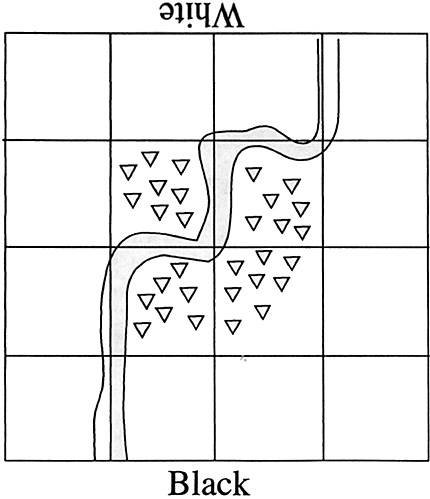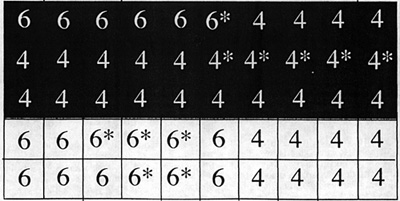 Inspired by the latest Command magazine, I felt my creative juices flowing and so
Strut & Conquer is proud to include its first game Warhammer Toe.
Inspired by the latest Command magazine, I felt my creative juices flowing and so
Strut & Conquer is proud to include its first game Warhammer Toe.
In this variation of the classic Tick Tack Toe, players will find a challenging game that goes well beyond the simple game of yore. Having stopped all design work for the past three minutes, I have every belief that this game will stand the test of lunchtime and become the classic that it deserves. Without further ado, here are the rules.
Introduction
This game is a two player game that requires two pencils, 2 four sided dice, 2 six sided dice, and one twenty sided die with all numbers painted over. The dice are not included in the game. Two pads of paper are also needed.
Preparation for Play
The counters should be cut out and mounted on foam board. The self adhesive foam board is the easiest way to do so. Then the counters should be cut out and sorted into two plies. The white on black counters to one side and the black on white counters on the other side. The game map should then be place in the center of a table and a 24" by 36" sheet of Plexiglas should be placed on top thus providing a protection against spilled drinks or cats with urinary track infections.
Players then should roll the twenty sided die. It is then placed to one side. Next each player rolls a different six sided die and the numbers are compared. The player with the highest die chooses which color counters first. The other player may not choose the same color counters as the first player.
In case of ties, the players should play one complete campaign game of Three Days of Gettysburg with the winner getting first choice of counters.
Alternatively, both players could determine who goes first in choosing by each pulling out all of their fingernails with the first completing this going first. While quicker, the fingernail approach is less painful and is only recommended if no copies of 3DoG have survived the ritualistic burning that most copies have been put through.
Counters
All counters have a number on them. This is the die that is rolled by that unit when attacking or defending. Units with a star after their number may use Turn Continuation and attack again.
Rules
The player with the most letters in his last name goes first. In case of a tie, see above.
Sequence of Play
The game is played in a series of game turns. Play is determined by the TCT die roll.
A. First Player Turn
1. First player of previous turn rolls a six sided die and checks the Turn Continuation Track. Should the result be a random even (RE)t. Then the Random Event Table is consulted and results are applied.
2. Player activated then places one counter on the map either in a friendly occupied box or in a box containing no counters.
3. Supply is checked.
4. Combat is then resolved and results are applied.
Second Player Phase
Same as above.
This continues until someone wins, someone dies, or both players fall asleep.
Stacking
Players may stack up to 4 counters in one square.
Supply
In order to be in supply, units must be able to trace a string of adjacent squares back to their side of the table that do not contain enemy units. If not in supply, a four sided die is rolled. The units are removed from play if a one is rolled.
Placing Counters
Placing counters only occurs during the player's own activation and only one is placed during that time. Units may not be placed in squares occupied by enemy counters.
Note: Eliminated units may be used again by utilizing the Resurrection Random Event.
Combat
To attack a square, all attacking units must be in an adjacent hex or be paratroop units. To attack, player rolls one die for each unit and totals the result. The defender then rolls one die for each defending unit. Defender also applies any defensive terrain bonuses.
Player with highest sum wins, and all opposing units are eliminated. In case of ties, see tie resolution in Preparing Play section. If a defending square becomes empty as a result of combat, then the opposing player may advance one of more units into the square. Units with a * may conduct another attack if their first attack resulted in all defending units being eliminated.
Paratroop Capabilities
Each player may conduct 4 paradrops during the game. To do so, the player takes a unit that is currently off the map. Before a combat begins, the player announces that he is planning a paradrop and moves the unit on top of the defending units. The player then rolls a 4 sided die.
On a die roll of 3 or 4, the unit is successful and is part of the combat with a -I added to that units die roll. On a die roll of 1 or 2, the unit immediately dies and is buried outside. Players may choose to have such a counter placed in the Tomb of the Unknown Counter and assign another counter as ceremonial guard. This is worth one prestige point. See random Events table for the Improved Gene Testing Event.
Entrenching
Units may instead of moving during the turn, be entrenched. This adds one to their die rolls for defense. An entrenched unit may not attack. If it does so, it is no longer entrenched.
To signify entrenchments, players are encouraged to cut grooves in the table the game is being played on and then place little wades of paper around the groove. Alternatively, the counter entrenched may be flipped over.
Air Power
Air power is abstracted. At the beginning of the game, each player creates three paper airplanes from the pads required for play. Before any attack, either player may attempt to use one of the airplanes as an added unit.
All airplanes have a six die for attack or defense. To attempt to use air power, the player stands 10 feet away from the board and throws the plane, if any part of it lands on the square being attacked then the air power roll may be used. If it fails, the opposing player may rip up the plane. Only one plane on each side may be used for a single combat.
Prestige
Prestige points may be used to add one to die rolls.
Victory Conditions
The first player to have four squares in a straight line or diagonal occupied by friendly units wins.
Credits:
Design: Rob Markham
Developer: Keith Poulter's spirit
Playtesters: To be announced at a further date.
Designer Notes:
Games such as Warhammer Toe are truly the next wave. Bringing the wargaming design mind to the problems of a classic game is one of the highest forms of design. Just being near such truths has made this design as divinely inspired as say the works of Leonardo (uhh, that's DiCaprio, not DaVinci).
Should you worry that this will be the last of its type of game you see, have no fear, upcoming issues will include Warhammer Toe II, Warhammer Toe II, and of course Warhammer Toe VIII. Think of this as the beginning of a lifetime of gaming. Also, if you actually do play the game, I'd like to know how it turned out, having never played it myself.
| Turn Continuation Table | |
|---|---|
| Die Roll | Result |
| 1 | Rolling Player Moves |
| 2 | Roll Again |
| 3 | Random Event |
| 4 | Random Events |
| 5 | Roll Again |
| 6 | Stare straight ahead for 5 minutes, then roll again |
Random Events Table
| Die Roll | Result |
|---|---|
| 1 | Warhammer |
| 2 | Gene Test |
| 3 | Switch Sides |
| 4 | Time Agent |
| 5 | Resurrection |
| 6 | ESP |
Result Explanations:
Warhammer: Player may pound the table as hard as possible and then eliminate any counters that are touching a line, are no longer in a square, or occupy a square with enemy units.
Gene Test: Player may eliminate the opposing player's Tomb of the Unknown Counter and gains a Prestige Point.
Switch Sides: Players must switch sides.
Time Agent: Player may start the game all over again.
Resurrection: Player rolls a six sided die and adds that number of eliminated units to his unit pool.
ESP: Player secretly writes a number from one to twenty on a sheet of paper. Then he rolls the twenty sided die. The opposing player then calls out a number from 1-20. If the number is the same as the number written on the paper then the writing player gains ESP ability. This he may use once. It allows him to reroll any die three times. He chooses which die roll to take.



Back to Strut and Conquer Vol. 1 Iss. 3 Table of Contents
Back to Strut and Conquer List of Issues
Back to MagWeb Master Magazine List
© Copyright 1999 by Markham Designs
This article appears in MagWeb (Magazine Web) on the Internet World Wide Web. Other military history articles and gaming articles are available at http://www.magweb.com